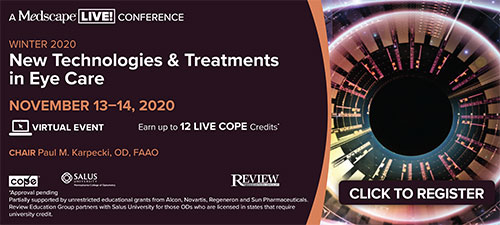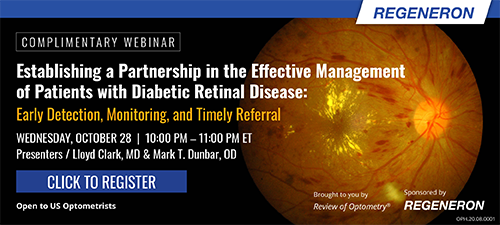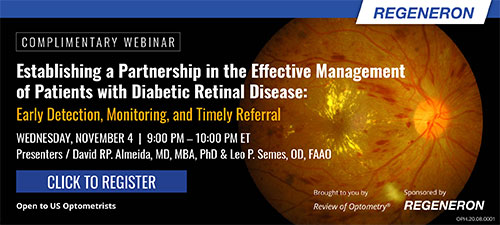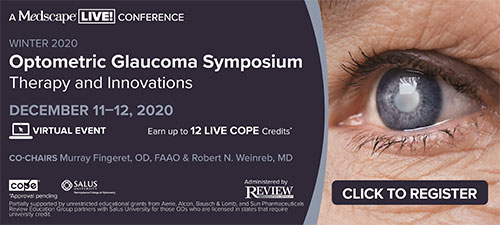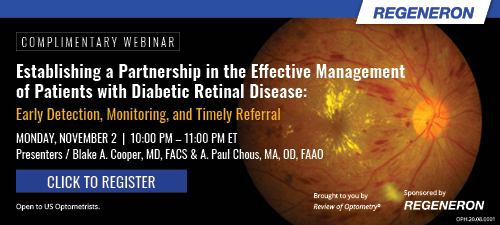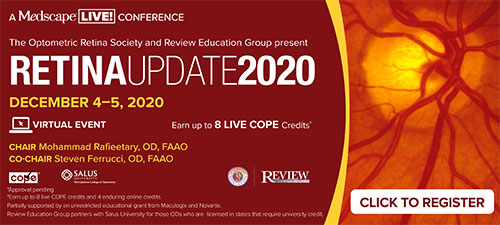
A
weekly e-journal by Art Epstein, OD, FAAO
Off the Cuff: The Next 18 Months: The Reality of COVID
Predicting the future is something best left for svengalis and CNN, but a bit of prescience can be quite valuable—especially in the difficult times we face today. The COVID pandemic has broken the CDC and the mainstream media, become a political hot potato, divided the country and created what may be the biggest gold rush for the pharmaceutical industry in history. It also has created opportunity for optometry.
|
|||||
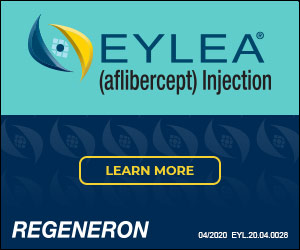 |
||
| Ocular Surface and Conjunctival Cytology Findings in Patients with Confirmed COVID-19 | ||||
To assess the effect of severe acute respiratory syndrome coronavirus-2 infection on the conjunctiva and tear film, 38 patients with confirmed COVID-19 and 31 healthy controls were included in this prospective and observational study. Individuals with COVID-19 formed the patient group, and healthy individuals formed the control group. Conjunctival impression cytology (CIC), TBUT, the Schirmer II test and the ocular surface disease index were evaluated in all participants. No significant difference was observed regarding the mean age and gender between the groups. The mean TBUT and Schirmer II test results did not differ between the two groups. The CIC results revealed decreased density and cell size of goblet cells, and moderate to high enlargement, squamous changes and increased nucleocytoplasmic ratio in non-goblet epithelial cells in the COVID-19 group compared with the control group. Based on the Nelson classification in CIC samples, 60.6% of the COVID-19 group and 19.4% of the control group had changes consistent with grade 2 or above. The presence of neutrophils in CIC was significantly higher in the COVID-19 group, whereas the presence of lymphocyte was similar between the two groups. |
||||
SOURCE: Bozkurt E, Özateş S, Muhafız E, et al. Ocular surface and conjunctival cytology findings in patients with confirmed COVID-19. Eye Contact Lens. 2020; Oct 13. [Epub ahead of print.] |
||||
 |
||
| Use of Digital Displays and Ocular Surface Alterations: a Review | ||||
Digital display use has been implicated as a contributing factor for dry eye disease (DED). Abnormal blinking during computer operation, including a reduced blink rate and an incomplete eyelid closure, increased palpebral fissure as a consequence of high visualization angles, and meibomian gland dysfunction associated with long-term display use, are behind the increased prevalence of dry eye signs and symptoms found in digital display users.
|
||||
| SOURCE: Talens-Estarelles C, García-Marqués JV, Cervino A, et al. Use of digital displays and ocular surface alterations: A review. Ocul Surf. 2020; Oct 11:S1542-0124(20)30151-8. [Epub ahead of print.] | ||||
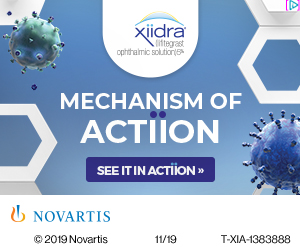 |
||
| Is Optometry Ready for Myopia Control? Education and Other Barriers to the Treatment of Myopia | ||||
With the increasing prevalence of myopia, there is growing interest in active myopia control. However, the majority of progressive myopes are still prescribed single vision spectacles. This prospective study aimed to elucidate the knowledge and attitudes of optometrists toward myopia control, and thereby identify perceived barriers to the implementation of a risk-focused model of myopia management. A series of four focus group discussions were conducted involving optometrists in different settings and career stages. The key finding to emerge is a clear disconnect between academic optometrists, optometry students and clinicians in practice. Academic faculty considered themselves competent in managing progressive myopia and believed the optometry curriculum provides undergraduates with sufficient clinical skills and knowledge to practice myopia control. Final-year optometry students regarded themselves as knowledgeable about myopia control but lack confidence in their ability to practice myopia control, with only one student indicating they would initiate myopia control therapy. The majority of clinicians did not offer myopia control treatments, other than to communicate lifestyle advice to modify risk of myopia progression. Clinicians alluded to a lack of availability of myopia control interventions, and identified a range of barriers relating to their training, clinical practice and public health challenges, in addition to financial, technological and other constraints that affect the implementation of such interventions. |
||||
| SOURCE: McCrann S, Flitcroft I, Loughman J. Is optometry ready for myopia control? Education and other barriers to the treatment of myopia. HRB Open Res. 2020; Apr 23;2:30. | ||||
| News & Notes | ||||||||
| AAOF Names Johnson & Johnson Vision J. Pat Cummings Scholarship, Vincent Salierno Scholarship Recipients The American Academy of Optometry Foundation, in collaboration with Johnson & Johnson Vision, announced the 2020 J. Pat Cummings Scholarship recipients. View the recipients. In addition, the AAOF announced the recipients of the 2020 Vincent Salierno Scholarships. View the recipients. |
||||||||
|
||||||||
| Eaglet Eye Announces Five More Labs Ready to DirectConnect Eaglet Eye announced five more labs are linked to DirectConnect, the Eye Surface Profiler (ESP) feature enabling direct transmission of the Profilometry data of the eye and all lens data to a lab of choice. DirectConnect is designed to increase accuracy of empirical fitting of specialty lenses. Bausch + Lomb, ScanFitPRO, AccuLens, X-Cel and AVT have been added, in addition to BostonSight and Blanchard, for a total of seven, with more labs coming soon. Learn more. |
||||||||
|
||||||||
| Oasis Introduces Cleansing Spray to Manage Eyelid Bioburden Oasis Medical, manufacturer and distributor of Soft Plug punctal plugs, Oasis Tears Preservative-Free Lubricating Eye Drops and Oasis Lid & Lash eyelid and lash hygiene wipes, is shipping its initial release of Oasis Tears Hypochlorous Eyelid Cleansing Spray to eye care providers in the US and taking preorders now for an end of October Launch. Oasis Tears Hypochlorous offers a gentle, non-toxic and naturally antimicrobial formula designed to reduce bioburden on the eyelids and lashes, and can be used daily. Learn more about Oasis. |
||||||||
|
||||||||
| BostonSight Increases Accessibility of HOA Correction in Vision Care BostonSight announced the HOA Collaborator Program, which partners with eyecare professionals to offer SmartSight higher order aberration correction technology in specialty lenses. BostonSight has been actively treating patients with HOA technology for more than 20 years, starting with front surface eccentricity features in their lenses and moving forward to full wavefront correction. The organization is expanding access to this technology to help additional patients who could benefit. Learn more. |
||||||||
|
||||||||
| Fighting Blindness to Host Free Webinar on Low Vision Resources and Rehabilitation for Retinal Degeneration Patients The Foundation Fighting Blindness is hosting a low vision webinar to inform eye care professionals about opportunities to enhance the quality of life for their retinal disease patients. The interactive webinar is appropriate for all eye care professionals including: retinal specialists, ophthalmologists, optometrists, rehabilitation professionals, occupational therapists, and orientation and mobility instructors. Registers for the webinar. |
||||||||
|
||||||||
| New Resource on Importance of Good Vision The National Center for Children’s Vision and Eye Health at Prevent Blindness and the National Head Start Association launched a free resource, the “Small Steps for Big Vision: An Eye Health Information Tool Kit” for Parents and Caregivers,” to provide parents and caregivers with information on caring for their children’s vision and eye health. At least one in five children enrolled in Head Start has an uncorrected vision disorder. And uncorrected refractive errors (including significant near-sightedness, far-sightedness and astigmatism) in preschool-age children can negatively impact early literacy skills and school readiness. Learn more. |
||||||||
|
||||||||
| Prevent Blindness Encourages Screen Time-outs Prevent Blindness is launching a campaign to try and reduce the effects of digital eye strain. With people spending more time viewing digital screens during the pandemic, the Screen Time-out program is a series of social media graphics reminding individuals to give their eyes a break. Graphics will run on Facebook, Instagram and Pinterest. A new webpage provides individuals with information on digital eye strain, blue light and other information on protecting vision. Learn more. |
||||||||
|
||||||||
|
Allergan Makes Updates to Team Allergan announced the retirement of Dave Gibson, associate VP of Consumer Eye Care and Customer Development after 20 years of service. Since 2009, Gibson has led Allergan’s Optometric Professional Relations team and helped launch a variety of programs to support the optometry community. He established several optometry programs at the company including Allergan’s Academic Partnership and Optometry Jumpstart. In addition, the company announced the promotion of Marcy DeWalt to executive director, Customer Development and Optometric Professional Relations; and Scott Berg to executive director, Consumer Eye Care Marketing. Personal note: I've known Dave Gibson for many years. Beyond being an incredible human being and a wonderful friend, Dave has been a steadfast champion for our profession and an incredible supporter of optometry. He is one of a very small number of industry people who has really made a difference. One of Allergan's greatest assets, Dave will be sorely missed. My best wishes on his retirement... |
||||||||
|
Optometric Physician™ (OP) newsletter is owned and published by Dr. Arthur Epstein. It is distributed by the Review Group, a Division of Jobson Medical Information LLC (JMI), 19 Campus Boulevard, Newtown Square, PA 19073. HOW TO ADVERTISE |


